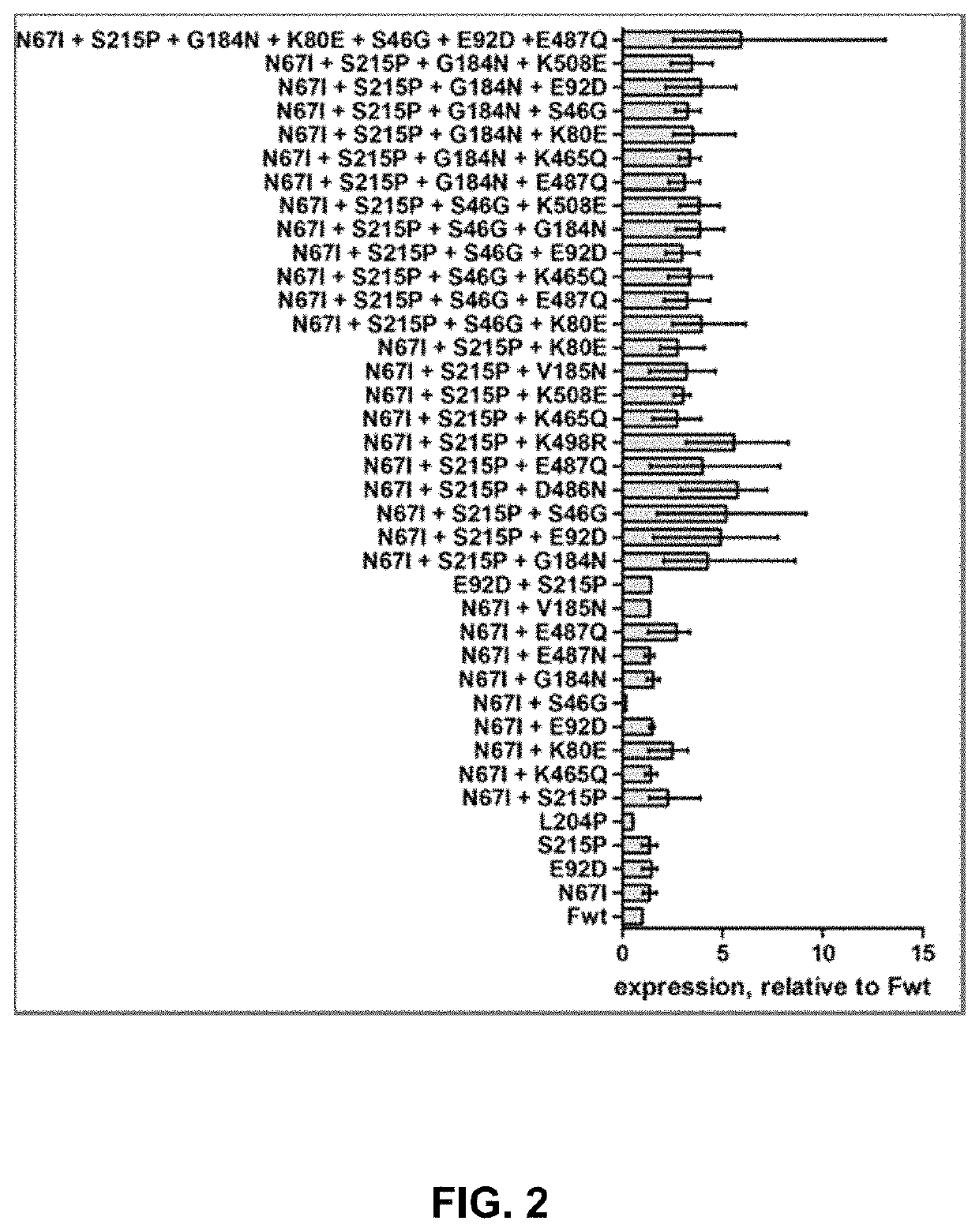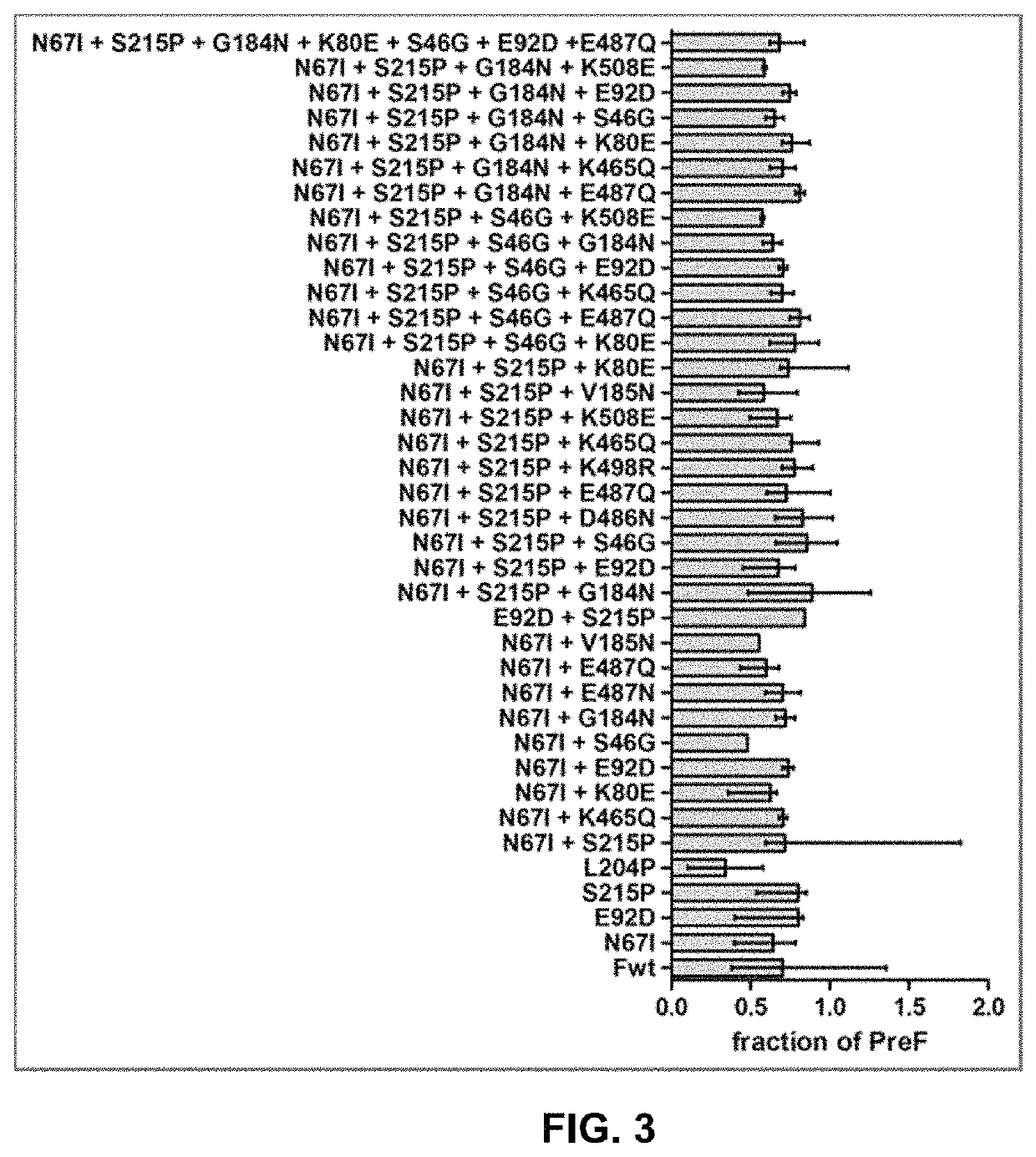Vaccine against RSV
a technology of rsv and vaccine, applied in the field of vaccine against rsv, can solve the problems of insufficient rsv vaccine, inability to obtain a license, and inability to effectively prevent the adverse effects of rsv infection, so as to reduce the incidence of rsv infection, reduce the adverse effects, and reduce the effect of infection and/or replication
- Summary
- Abstract
- Description
- Claims
- Application Information
AI Technical Summary
Problems solved by technology
Method used
Image
Examples
example 1
ng the RSV F Protein in its Pre Fusion Conformation
[0086]Plasmids encoding basic RSV F sequences were synthesized and the amino acid substitutions were introduced in the protein by site-directed mutagenesis. The protein variants were transiently expressed in HEK293 cells. The relative protein expression on the cell surface was assessed by Flow Cytometry. The stability of the F proteins in pre-fusion conformation was evaluated in a heat-stability assay.
[0087]The protein sequence used for RSV A2 F protein variants was retrieved from the GenBank, accession number ACO83301.1. The amino acid substitutions were introduced in the sequence by site-directed mutagenesis (QuikChange II XL Site-Directed Mutagenesis Kit, Agilent technologies). The mutagenesis primers were designed using on-line tool PrimerX. HEK293T cells (CRL-11268) were purchased from American Tissue Culture Collection and cultured under standard cell culture conditions (37° C., 10% CO2).
[0088]Fully human IgG1 anti-RSV F prote...
example 2
on of Adenoviral Vectors
Cloning RSV F Gene into E1 Region of Ad35 and Ad26:
[0109]The nucleic acid sequences, coding for the pre-fusion F proteins of the invention were gene optimized for human expression and synthesized, by Geneart. A Kozak sequence (5′ GCCACC 3′ (SEQ ID NO: 5)) was included directly in front of the ATG start codon, and two stop codons (5′ TGA TAA 3′ (SEQ ID NO: 6)) were added at the end of the RSV.pre-F coding sequence. The RSV.pre-F genes were inserted in the pAdApt35BSU plasmid and in the pAdApt26 plasmid via HindIII and XbaI sites.
Cell Culture:
[0110]PER.C6 cells (Fallaux et al., 1998, Hum Gene Ther 9: 1909-1917) were maintained in Dulbecco's modified Eagle's medium (DMEM) with 10% fetal bovine serum (FBS), supplemented with 10 mM MgCl2.
Adenovirus Generation, Infections and Passaging:
[0111]All adenoviruses were generated in PER.C6® cells by single homologous recombination and produced as previously described (for rAd35: Havenga et al., 2006, J. Gen. Virol. 87: 21...
example 3
of Immunity Against RSV F Using Recombinant Adenovirus Serotypes 26 and 35 Expressing Pre Fusion RSV F In Vivo
[0112]The immunogenicity of Ad26.RSV.preF2.1 and Ad26.RSV.preF.2.2 was evaluated in mice, comparing cellular and humoral immune responses to responses induced by identical doses of Ad26.RSV.FA2 (i.e. expressing the wild type RSV F protein). Balb / c mice (n=4 per group) were immunized with the indicated dose of 108 to 1010 viral particles (vp) Ad26.RSV.FA2 or Ad26.RSV.preF2.1 or Ad26.RSV.preF2.2, or with formulation buffer. At 8 weeks after prime, the number of RSV F A2 specific IFNγ spot forming units (SFU) per 106 splenocytes was determined using ELISpot. It was shown that Ad26.RSV.preF2.1 and Ad26.RSV.preF.2.2 induced increased humoral immune responses in mice when compared to Ad26.RSV.FA2, with broad neutralizing capacity and maintained cellular responses. A single intramuscular immunization with Ad26.RSV.preF2.1 and Ad26.RSV.preF.2.2 elicited a cellular response (FIG. 7) ...
PUM
| Property | Measurement | Unit |
|---|---|---|
| temperature | aaaaa | aaaaa |
| temperature | aaaaa | aaaaa |
| temperature | aaaaa | aaaaa |
Abstract
Description
Claims
Application Information
 Login to View More
Login to View More - R&D
- Intellectual Property
- Life Sciences
- Materials
- Tech Scout
- Unparalleled Data Quality
- Higher Quality Content
- 60% Fewer Hallucinations
Browse by: Latest US Patents, China's latest patents, Technical Efficacy Thesaurus, Application Domain, Technology Topic, Popular Technical Reports.
© 2025 PatSnap. All rights reserved.Legal|Privacy policy|Modern Slavery Act Transparency Statement|Sitemap|About US| Contact US: help@patsnap.com



